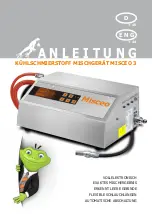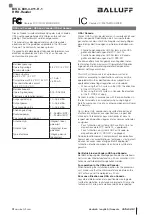
18
5
INSPECTION AND MAINTENANCE
5.1
GENERAL MAINTENANCE RULES
1.
Do not allow persons other than authorized service personnel to repair this equipment.
2.
Do not weld or otherwise modify the lift. Such alterations may weaken the structural integrity of the lift and invalidate
your warranty.
3.
Completely lower the lift before performing any type of maintenance or repair.
WARNING:
NEVER ALLOW ANYBODY TO WORK IN OR ON THE BOAT WHEN IT IS SUSPENDED
ABOVE THE WATER ON THE LIFT. IF THE HANDWHEEL ON THE WINCH SHOULD
START FREEWHEELING, DEATH OR SERIOUS INJURY COULD RESULT.
IF FREEWHEELING STARTS, NEVER TRY TO STOP IT. ALTHOUGH A SPIN DOWN OR
“FREEWHEELING” CAN CAUSE LIFT OR BOAT DAMAGE, TRYING TO STOP
FREEWHEELING CAN CAUSE SERIOUS PERSONAL INJURY.
5.2
WIRE ROPE INSPECTION PROCEDURE
Inspect the wire rope prior to each use for signs of wear, damage, or pinching. Inspect the entire wire rope working length.
Thoroughly inspect the rope sections that pass over sheaves or drums, or that make opposing turns. Inspect wire rope and
end attachments carefully. While inspecting, examine sheaves, guards, guides, drums, flanges, and other surfaces contacting
wire rope during operation. Correct any condition harming the rope in use or other damage or worn surfaces at this time.
CAUTION:
WEAR HEAVY LEATHER GLOVES WHEN HANDLING WIRE ROPE. INSUFFICIENT
HAND PROTECTION WHEN HANDLING WIRE ROPE CAN CAUSE PERSONAL INJURY.
Remove and immediately replace wire rope with one or more of the following defects:
1.
Corrosion
2.
Broken wires:
(a)
One or more valley breaks. A valley break is a wire break occurring in the valley between two adjacent strands.
(b)
Six randomly distributed broken wires in one rope lay. A rope lay is the length of rope along which one strand
makes a complete revolution around the rope. See Figure 5-1. Keeping the rope clean and wound evenly on the
winch drum will increase its life and efficiency.
3.
Abrasion: Scrubbing, flattening or peening causing loss of more than one-third of the original diameter of the outside
wires.
4.
Kinking: Severe kinking, crushing, bird caging or other damage causing distortion of the rope structure. Bird caging is
a bulging in the cable caused by the individual wires becoming untwisted. This untwisting of individual wires is usually
caused by impact loading on the cable (such as a sudden stop).
5.
Heat damage: Evidence of any heat damage caused by a torch or by contact with electrical wires.












































